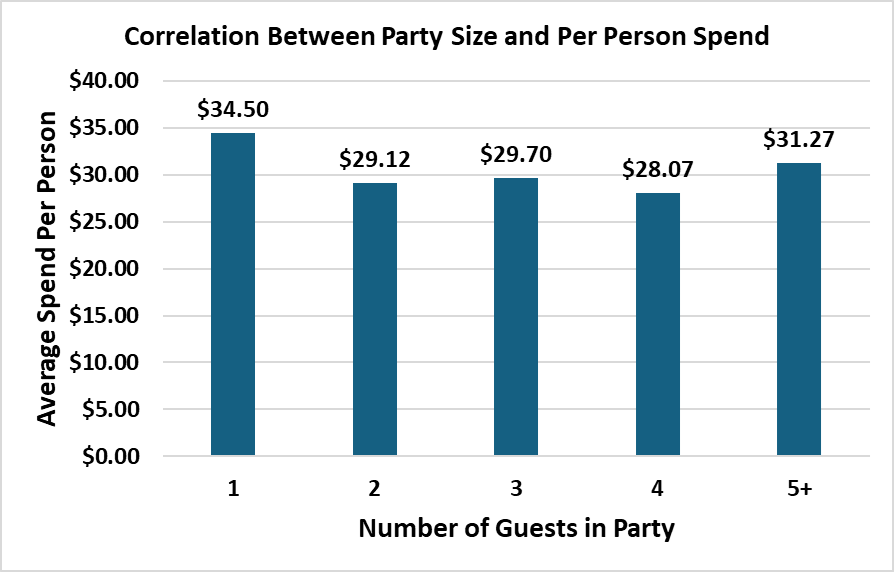How Party Size Impacts Taproom Spending
Does the solo guest or larger party spend more money in your taproom? Is your staff offering each group the same level of engagement? How can you use this data to create more memorable and profitable experiences for all?
First, let’s look at some data on the frequency of different party sizes in the average taproom:
For our study, we analyzed parties of 1, 2, 3, 4, and 5+.
Parties of 2 are the most common, accounting for nearly half (46%) of the groups visiting taprooms.
Parties of 1, 3, 4, and 5+ occur at similar rates, falling within 1.5 percentage points of each other in terms of frequency.
Interestingly, we see a near-negative correlation between party size and the likelihood of receiving a high level of engagement from staff. Single guests are 46% likely to receive high engagement, whereas parties of 5 or more are only 35% likely to experience this same level of service.
Now, how does this translate to spending? Solo guests spend the most per person, averaging $34.50. Guests in groups of 2 to 4 spend between $28.07 and $29.70 per person, while those in parties of 5 or more see their average per person spend jump to $31.27.
Additionally, guests who receive a high level of engagement spend 30% more than those who experience low engagement. It's no surprise, then, that the solo guest—who is more likely to receive personalized attention—is also spending more.
Perhaps when a group reaches a size of 5 or more, they hit a tipping point where the energy and vibe create a livelier atmosphere, resulting in higher spending. This observation ties into a prior study that analyzed how the level of busyness in a taproom correlates with guest spending. We found that taproom guests tend to spend more money as the busyness increases. Simply put, if you’re the only person in a taproom, you’re probably not motivated to stay for hours. However, when you add a few friends and some background noise, the vibe becomes more enjoyable, and your wallet tends to open a bit more. A large group acts as a microcosm of a busy taproom.
While we see an increase in spending per person for large parties (5 or more), this does not translate to a higher tipping amount. Engagement directly correlates with tip percentage: the more engagement a staff member provides, the higher the guest's tip. With single guests being 31% more likely to receive a high level of engagement than parties of 5 or more, it’s no surprise that individual guests tip at a higher rate. Solo guests tip an average of 27.6%, while guests in groups of 5 or more tip an average of 18.7%.
Remember the New Radicals song “You Get What You Give”? Tipping is kind of like that.
“Fashion shoots with Beck and Hanson
Courtney Love and Marilyn Manson
Taproom guests with phones and laptops
Want to talk less and drink more hops”
We find that the "sweet spot" for busyness and average guest spending occurs when the taproom is three-quarters full. At this capacity, the average tab is $56.48, compared to $47.55 in an empty taproom and $56.14 in a packed house. Notably, data from 2021-2022 indicates that fully packed taprooms saw the highest average tab size at $56.56, slightly edging out three-quarters full taprooms, which had an average of $56.05. This busier atmosphere facilitates higher guest spending.
When interacting with guests, it’s essential to customize the experience and level of engagement based on the party’s needs. A solo guest working on a laptop requires a different approach than a single visitor who is curious about your brand and orders a flight. Additionally, larger parties, such as a group celebrating a special occasion versus a homebrew club hosting their monthly meetup, will also require tailored interactions.
While this may seem like common sense, we have all experienced times when we did not receive the appropriate level of engagement, for better or worse. A solo guest on a laptop can be provided with a high level of hospitality through brief interactions, while larger parties may benefit from a focus on the group, their occasion, and overall needs rather than intimate, individual attention.
Regardless of party size, always ask yourself, “Are they showing signs of interest in engaging outside their party?” If not, adopt a "less is more" approach and engage respectfully when appropriate. If they are open to conversation beyond their group, seize the opportunity to personalize their experience based on contextual clues.
Understanding the dynamics of guest engagement and spending patterns in a taproom is crucial for enhancing the overall experience and maximizing profitability. Tailoring engagement to the unique needs of each party size—whether dealing with solo guests seeking solitude, individuals eager to learn more about your offerings, or larger groups celebrating special occasions—ensures that every visitor feels valued and engaged. By paying attention to guests’ cues and adapting your approach accordingly, you can drive higher spending and satisfaction.
A thoughtful, personalized approach to guest engagement fosters a welcoming atmosphere that encourages return visits and positive word-of-mouth. Ultimately, leveraging insights from party dynamics and engagement levels will set your establishment apart and help build a loyal customer base that appreciates the effort you put into making their visit truly special.
The data was collected from a set of 1278 unique taproom visits from November 16, 2022 to February 27, 2024. Each tab represents 2 guests and includes tax and tip.


